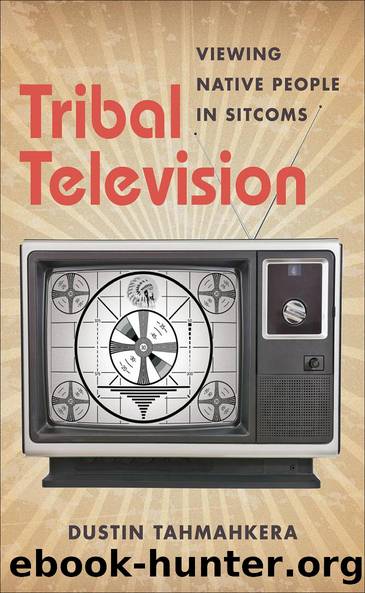Tribal Television by Dustin Tahmahkera

Author:Dustin Tahmahkera [Tahmahkera, Dustin]
Language: eng
Format: epub
Tags: Performing Arts, Television, History & Criticism, Social Science, Ethnic Studies, American, Native American Studies, Media Studies
ISBN: 9781469618685
Google: p0GbBAAAQBAJ
Publisher: UNC Press Books
Published: 2014-01-15T04:05:56+00:00
Redcorn boldly claims the object belongs to him, yet his solution is to house it âin a museum,â a stark contrast to his initial outrage and to Nativesâ historical and ongoing repatriation efforts and calls for museums and universities to return, not possess and preserve, their peopleâs cultural items. Then on the following page, Redcorn all but admits he has previously sold tribal objects to the archaeologist when he advises Hank to proceed with caution: âDo not take his first offer.â More damning for Redcornâs cultural integrity is a producerâs handwritten note next to Redcornâs line concerning âwhat is already mineâ: âlooks valuable I sold stuff to univ[ersity] 300 bucks.â44
In act 3 of the beat sheet for âThe Arrowhead,â âHank hears from Redcorn that Native Americansâ land was takenâjust as Hankâs land is being taken. This is interesting [to] Hank. They go off to talk more about it.â Once they arrive âat Redcornâs, Hank is interested to learn about history.â45 Hank and Redcorn share narratives of land loss, but to equate the two land thefts drastically downplays the indigenous-settler specificities of broken treaties, violence, assimilation efforts, and racism, not to mention absolves Hank of any personal guilt or responsibility (evocative of the outcome in the aforementioned episode with Bernie Mac) as a contemporary settler living on a piece of land that, according to Aibel and Bergerâs pitch, was formerly inhabited by Redcornâs grandfather.
When Hank digs in his yard and finds âan old retail sign which reads âSouvenirs,ââ Hank pursues its origins at âthe downtown Hall of Records and finds out that his parcel of land was zoned as a souvenir store in the 1920s. . . . John Redcornâs grandfather ran it.â46 Meanwhile, the archaeologists resume digging up Hankâs yard and suspect they have found âmysterious and wondrous glyphsâ on âan old metal sign of some kind.â After Aibel and Berger make a migratory turn toward the highly contested Bering Strait theoryââIt bears a striking resemblance,â they note, âto Asian text characters and Indio-European writingsâââHank proves them all wrong by whipping out his garden hose and s[p]raying the dirt off the signâan old retail sign which reads âSouvenirs.ââ47 What began as the development of a resolution involving Hank and Redcorn working together soon becomes Hankâs show in representing his version of settler self-determination.
Redcorn, however, was not the only indigenous character to intervene in Hankâs land dilemma in the pitch. Aibel and Berger posed an additional story line that, if aired, would have introduced several other opportunistic Indian characters. The writersâ submission of other Indians is highly unusual, considering that Redcornâs only blood relation ever depicted in any of the 259 episodes of King of the Hill is his son, Joseph, and, in one late episode, his previously unknown daughter, Kate. Other relations very briefly reference Redcornâs father (John Redcorn II), grandfather (John Redcorn I), and a sister. For Aibel and Berger to pitch multiple Indian characters could be deemed a feat in itself, yet their Indians quickly slip into a regressive camp of representations.
Download
This site does not store any files on its server. We only index and link to content provided by other sites. Please contact the content providers to delete copyright contents if any and email us, we'll remove relevant links or contents immediately.
| 19th Century | 20th Century |
| Exploration | First Nations |
| Founding | Pre-Confederation |
| Province & Local | War of 1812 |
Cat's cradle by Kurt Vonnegut(15257)
Pimp by Iceberg Slim(14433)
4 3 2 1: A Novel by Paul Auster(12329)
Underground: A Human History of the Worlds Beneath Our Feet by Will Hunt(12052)
The Radium Girls by Kate Moore(11970)
Wiseguy by Nicholas Pileggi(5707)
The Fire Next Time by James Baldwin(5380)
Perfect Rhythm by Jae(5354)
American History Stories, Volume III (Yesterday's Classics) by Pratt Mara L(5274)
Paper Towns by Green John(5136)
Pale Blue Dot by Carl Sagan(4953)
A Higher Loyalty: Truth, Lies, and Leadership by James Comey(4905)
The Mayflower and the Pilgrims' New World by Nathaniel Philbrick(4458)
The Doomsday Machine by Daniel Ellsberg(4449)
Killers of the Flower Moon: The Osage Murders and the Birth of the FBI by David Grann(4409)
The Sympathizer by Viet Thanh Nguyen(4338)
Too Much and Not the Mood by Durga Chew-Bose(4302)
The Borden Murders by Sarah Miller(4275)
Sticky Fingers by Joe Hagan(4143)
